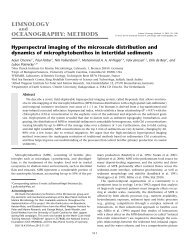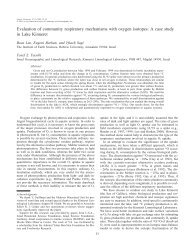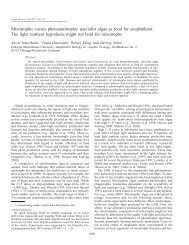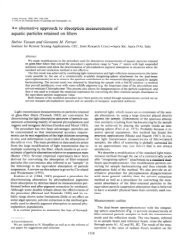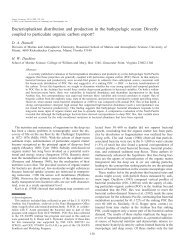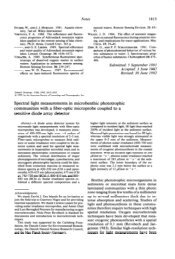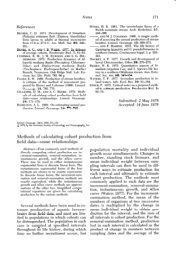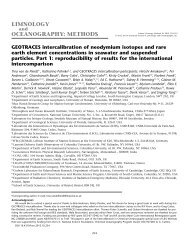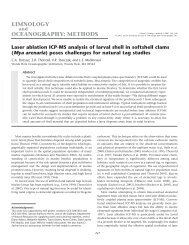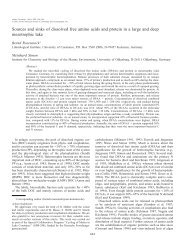Chia Yu Lin and Steven L. Manley. Bromoform production from - ASLO
Chia Yu Lin and Steven L. Manley. Bromoform production from - ASLO
Chia Yu Lin and Steven L. Manley. Bromoform production from - ASLO
You also want an ePaper? Increase the reach of your titles
YUMPU automatically turns print PDFs into web optimized ePapers that Google loves.
MSNDC Award Lecture<br />
Javier Garcia de Jalon<br />
Universidad Politécnica de Madrid,<br />
Spain<br />
Wednesday, August 31, 2011 Session: MSNDC 7-2<br />
10:40am–12:00pm Location: Regency B<br />
2011 D’Alembert Award Lecture (MSNDC)<br />
Multibody Systems Made Simple <strong>and</strong> Efficient<br />
The first part of this presentation reviews the origin <strong>and</strong> initial<br />
development of natural or fully Cartesian coordinates. These<br />
coordinates allow the description of position <strong>and</strong> orientation of<br />
3-D multibody systems in a straightforward way, with the<br />
constraint equations formulated in terms of dot <strong>and</strong> cross<br />
products of vectors. The simplicity of these constraint equations<br />
promotes some developments in dynamic formulations based<br />
on the use of both dependent <strong>and</strong> independent coordinates.<br />
Redundant constraints <strong>and</strong> singular mass matrices can be set<br />
out <strong>and</strong> solved in a direct <strong>and</strong> simple way. The second part of<br />
this presentation deals with the application of natural<br />
coordinates in three important areas: flexible multibody systems,<br />
the capture <strong>and</strong> reconstruction of the human body motion, <strong>and</strong><br />
optimization. Finally the evolution of global formulations based<br />
on natural coordinates to semi-recursive topological<br />
formulations using relative coordinates is described in detail.<br />
Such evolution allows a higher level of efficiency while retaining<br />
the simplicity of the mathematical development, the numerical<br />
algorithms, <strong>and</strong> the implementation in current computers. The<br />
different issues included in this presentation are illustrated with<br />
classical <strong>and</strong> modern examples, such as small <strong>and</strong> large<br />
systems or academic <strong>and</strong> practical cases. Some theoretical<br />
contributions <strong>from</strong> other authors are also mentioned in the<br />
context of natural coordinates <strong>and</strong> their evolution.<br />
27<br />
KEYNOTE AND AWARD LECTURES<br />
Biographical Description: Professor Javier García de Jalón<br />
was born in Zaragoza (Spain) in 1949. He graduated in<br />
Mechanical Engineering <strong>from</strong> the University of Navarre at San<br />
Sebastián (Spain) in 1971, <strong>and</strong> received his Ph.D. in September<br />
1977 in Computational Mechanics. In 1977 he moved to the<br />
School of Engineering of Bilbao, where he started his work in<br />
kinematics <strong>and</strong> dynamics of multibody systems, becoming a full<br />
professor on Mechanisms <strong>and</strong> Machines in 1980. In 1979 he<br />
started the development of the so-called “natural coordinates”,<br />
a system of generalized coordinates that bypasses the use of<br />
angles to describe the configuration of a multibody system.<br />
These coordinates seamlessly connect the kinematics <strong>and</strong><br />
dynamics of multibody systems with finite-element models <strong>and</strong><br />
optical motion-capture systems. Since their initial formulation,<br />
these coordinates have found numerous applications, including<br />
to the study of flexible bodies <strong>and</strong> biomechanics. In 1981 Prof.<br />
García de Jalón returned to San Sebastián <strong>and</strong> until 2000 he<br />
worked in the Applied Mechanics Department of the University<br />
of Navarre <strong>and</strong> CEIT (Centre of Technical <strong>and</strong> Research Studies<br />
of Gipuzkoa), where he served as Professor, senior Researcher,<br />
<strong>and</strong> Head of the Department. In 2000 he moved to the<br />
Universidad Politécnica de Madrid, where he is Professor of<br />
Applied Mathematics in the Mechanical Engineering School. He<br />
also works for INSIA (University Institute for Automobile<br />
Research), where he develops methods <strong>and</strong> software for real<br />
time simulation, design, <strong>and</strong> parameter identification of vehicles.<br />
Prof. García de Jalón has authored over 80 papers in<br />
international Journal <strong>and</strong> Conferences. In 1994 he co-authored<br />
with Prof. Bayo the book “Kinematic <strong>and</strong> Dynamic Simulation of<br />
Multibody Systems -The Real Time Challenge-”, that mostly<br />
summarizes the theory on natural coordinates <strong>and</strong> penalty<br />
methods as a way to enforce kinematic constraints. He has<br />
supervised 19 doctoral dissertations, among them seven<br />
university professors. In a 1987 talk at the VIIth IFTóMM World<br />
Congress on the Theory of Machines <strong>and</strong> Mechanisms, in Seville<br />
(Spain), he presented a multibody kinematic <strong>and</strong> dynamic<br />
program that ran interactively with realistic CAD models on one<br />
of the first 3-D graphic workstations. This was the starting point<br />
for a large activity of research <strong>and</strong> consulting work for many<br />
institutions, including the ESA (European Space Agency),<br />
Mechanical Dynamics, Inc., <strong>and</strong> other Spanish <strong>and</strong> European<br />
institutions.




